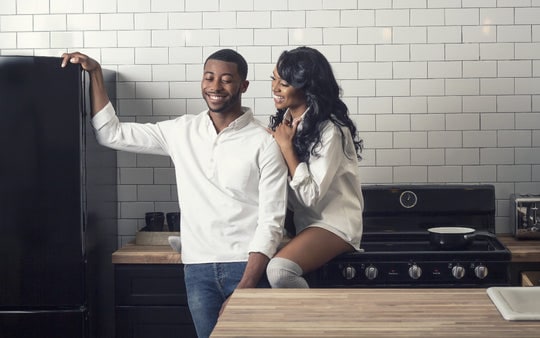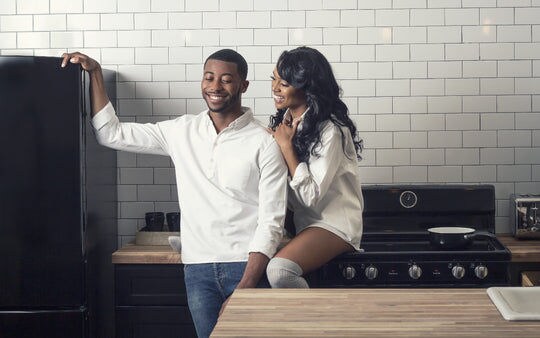Burnt porridge, scorched rice, boiled eggs that explode… This never used to happen in your Mom’s kitchen!
If you’re a new family, food preparation is about to become an inescapable part of your life.
Maybe you won’t set the pasta on fire, melt the spatula or get a pancake stuck to the ceiling, but it’s impossible to avoid all cooking fails along the way. Even so, there are certain rules surrounding kitchens and hob safety that you need to know about.
We’re all familiar with kitchens and what happens in them, but that doesn’t automatically make us experts. There are certain things you should know before you don an apron and get cooking for yourselves.
Hob Safety
Cooking can be fun, still, it’s easy to make mistakes. As with any situation, the more you know, the better prepared you’ll be. Understanding how hobs work can help you get the most out of your cooker.
There are four basic types that come as freestanding stoves or as built-in hobs.
What is an electric hob? This is a hob that is electrically powered, opposed to gas-fueled. The different types of electric hob include solid plate, ceramic and induction. We’ll compare each of these, without forgetting about good old gas.
What Is a Solid Plate Hob?
Solid plate hobs are heated through metal plates. They are a more traditional type of stovetop. Since the technology is quite simple, there are only a few solid plate hob pros and cons to discuss.
Pros
● Offer even distribution of heat
● Usually more affordable
Cons
● The least energy-efficient hob
● Heating up and cooling down takes time
● Residual heat is quite high
What is a Ceramic Hob?
A ceramic hob has heating elements beneath a glass or ceramic plate. They are a popular choice in modern homes because they look smart in any kitchen.
Here are the pros and cons of ceramic hobs:
Pros
● Easy to clean
● Suitable for all types of cookware
Cons
● Heating up and cooling down takes time
● Heat distribution isn't ideal
One quick note, cooking temperatures can be difficult to control with ceramic hobs and solid plates. For example, bringing food down from a boil to a simmer might be a bit tricky. When a hob is responsive to temperature changes, it’s easier to make adjustments while you’re cooking.
What is an Induction hob?
Induction hobs take the best of solid plates and ceramic hobs, creating an improved cooking experience.
They work with electromagnetic technology. This means a small electric current is triggered by a magnetic field. The hob won’t turn on unless the right kind of cookware is placed on the glass plate of the hob. Only the surface in contact with the cookware will get hot.
Pros
● Easy to clean
● Energy efficient
● User-friendly
● Temperature changes can be made relatively quickly
● The safest type of cooker you can get
● Limited residual heat
● Even distribution of heat
Cons
● More expensive
● Only steel or cast iron cookware can be used
What is a Gas Hob?
As the name suggests, with gas hobs, gas fuels the burners and is ignited as a heat source. The heat is an instant flame that is evenly distributed.
What safety features does a gas hob have? Most gas hobs come with a flame failure safety device. However, some older models might not have this feature. Another safety feature is special locks so those little ones can’t turn the gas on by themselves.
Pros
● More affordable than electric options
● More energy efficiency
● User-friendly
● You have better control of the cooking temperature
● Limited residual heat
● Even distribution of heat
Cons
● A liquid spill can put the flame out
● Not the easiest appliance to clean
● Not considered as safe as other options due to the naked flame
Kitchen Safety
Did you know that the kitchen is one of the most dangerous rooms in the house? Every year, 350,000 people hurt themselves with kitchen knives.
Making the food is one thing. Navigating the kitchen workspace can be a different story. Even experienced cooks get a bit clumsy in an unfamiliar kitchen.
It’s understandable if you’re accident-prone as a cooking newbie. But, there are a few important precautions we all need to take. Especially when it comes to hob safety.
These safety rules must be followed when using a hob:
● Don’t use a pot that’s too big or too small for a burner or hot plate
● When you remove a pot or a pan from the hob, always remember to turn off the heat
● Never leave an empty pan on a hot stove
● Pot handles that are turned outwards can easily be bumped, so turn handles inwards
Here are a few habits that make a kitchen safe:
● Make sure you store sharp knives appropriately
● Electrical appliances must be switched off at the plug when they’re not being used
● Be careful of appliance cables; you don’t want a cord to run near the hob
● Faulty appliances can start fires
● Bacteria can make you ill, so keep work surfaces clean
● Avoid cross-contamination by storing meats separately, refrigerating or freezing them
● Always wash your hands before touching food, and after you’ve handled meat
● Keep oven gloves in easy reach so that you don’t burn yourself
Safe practices extend a little further. Be aware of who is with you in the kitchen. Do you have a little one likely to pull something off the stove or demand to be included while you’re cooking? Will your cat or dog run under your feet?
Yet another consideration is multi-tasking. If you’re distracted you’re more likely to have an accident. So pay attention to what you’re doing. Oh, and put your mobile phone down and concentrate!
It may seem old-school, but it’s actually a good idea to wear an apron, remove your jewellery and tie long hair back. Loose hair, clothes, or accessories can be a problem. For example, a bracelet can catch on a pot handle spilling boiling food and causing serious burns. Or, if you’re wearing a loose shirt it could fall against the hob and catch on fire.
A quick note on oil and fire. If oil starts to smoke, get your fire extinguisher ready. Or, better yet, turn off the heat and let it cool before you have to call the fire brigade.
If oil catches alight, NEVER use water to douse the flames. It will make it worse. Turn off the heat and cover the flame with a lid or a wet towel if you can do so safely.
Cooking Up a Storm
What if you’re new to cooking? Don’t feel insecure about your skills! Do a bit of preparation beforehand and start small. A little practice goes a long way.
A great way to gain experience is to get a few simple recipes that you can experiment with. If you’re not sure about something you can always Google it. Or simply stay tuned to our lifestyle blog page with recipes, tips, and ideas for living your best life.
A kitchen is a great place for your family to hang out, cook, eat, and just be together. It might be the most popular part of your house, but that doesn’t mean it’s the safest. Remember your good habits and hob safety.
If you need some advice on the right cooker for your kitchen, the team at Defy can guide you in the right direction. Contact them here.


